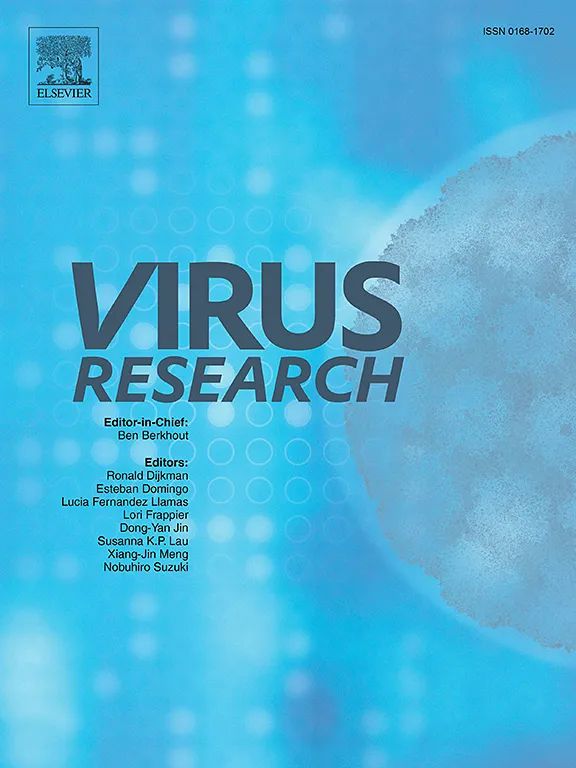Dothistroma septosporum 和 Dothistroma pini 是 Dothistroma 针叶枯萎病的病原菌,它们受到多种病毒的感染。
IF 2.5
4区 医学
Q3 VIROLOGY
引用次数: 0
摘要
Dothistroma septosporum 和 Dothistroma pini 是针叶树的严重叶片病原体。它们会感染多种寄主(主要是松树属),导致松树叶片萎黄、针叶脱落,在极端情况下最终导致松树死亡。霉形体病毒是控制病原体的一种新型创新途径。为了寻找 Dothistroma 属可能寄生的病毒,我们对来自捷克共和国、斯洛文尼亚、意大利和爱尔兰的分离物(20 株 D. septosporum 和 1 株 D. pini)进行了病毒 dsRNA 片段筛选。其中只有 5 株显示存在 dsRNA 片段。共制备了 21 个真菌分离物用于提取总 RNA。对 RNA 样品进行汇集,并构建了两个独立的 RNA 文库,用于链式总 RNA 测序。RNA-Seq数据处理、成对序列比较(PASC)和系统进化分析发现了13种不同基因组类型的新型假定病毒:七种负义单链 RNA 病毒,包括六种布尼亚类病毒和一种 Mononegavirales 目新成员;三种正义单链 RNA 病毒,其中两种与 Narnaviridae 科病毒相似,第三种的基因组与 Gammaflexiviridae 科病毒相对应;三种双链 RNA 病毒,包括两种 Chrysoviridae 科新成员和一种潜在的 gammapartitivirus 新种。通过 RT-PCR 筛选,结果证实真菌病原体寄生了所有病毒,并表明特定真菌菌株可携带多种病毒感染,而且病毒可垂直传播。在这项研究中,我们描述了感染 D. pini 的纳尼亚病毒。据我们所知,这是首次在 D. pini 中发现病毒。本文章由计算机程序翻译,如有差异,请以英文原文为准。
Dothistroma septosporum and Dothistroma pini, the causal agents of Dothistroma needle blight, are infected by multiple viruses
Dothistroma septosporum and Dothistroma pini are severe foliar pathogens of conifers. They infect a broad spectrum of hosts (mainly Pinus spp.), causing chlorosis, defoliation of needles, and eventually the death of pine trees in extreme cases. Mycoviruses represent a novel and innovative avenue for controlling pathogens. To search for possible viruses hosted by Dothistroma spp. we screened a subset of isolates (20 strains of D. septosporum and one D. pini) originating from the Czech Republic, Slovenia, Italy, Austria and Ireland for viral dsRNA segments. Only five of them showed the presence of dsRNA segments. A total of 21 fungal isolates were prepared for total RNA extractions. RNA samples were pooled, and two separate RNA libraries were constructed for stranded total RNA sequencing. RNA-Seq data processing, pairwise sequence comparisons (PASC) and phylogenetic analyses revealed the presence of thirteen novel putative viruses with varying genome types: seven negative-sense single-stranded RNA viruses, including six bunya-like viruses and one new member of the order Mononegavirales; three positive-sense single-stranded RNA viruses, two of which are similar to those of the family Narnaviridae, while the genome of the third correspond to those of the family Gammaflexiviridae; and three double-stranded RNA viruses, comprising two novel members of the family Chrysoviridae and a potentially new species of gammapartitivirus. The results were confirmed with RT-PCR screening that the fungal pathogens hosted all the viruses and showed that particular fungal strains harbour multiple virus infections and that they are transmitted vertically. In this study, we described the narnavirus infecting D. pini. To our knowledge, this is the first virus discovered in D. pini.
求助全文
通过发布文献求助,成功后即可免费获取论文全文。
去求助
来源期刊

Virus research
医学-病毒学
CiteScore
9.50
自引率
2.00%
发文量
239
审稿时长
43 days
期刊介绍:
Virus Research provides a means of fast publication for original papers on fundamental research in virology. Contributions on new developments concerning virus structure, replication, pathogenesis and evolution are encouraged. These include reports describing virus morphology, the function and antigenic analysis of virus structural components, virus genome structure and expression, analysis on virus replication processes, virus evolution in connection with antiviral interventions, effects of viruses on their host cells, particularly on the immune system, and the pathogenesis of virus infections, including oncogene activation and transduction.
 求助内容:
求助内容: 应助结果提醒方式:
应助结果提醒方式:


